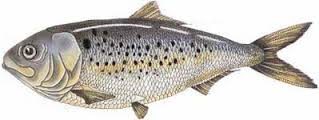
Menhaden, Brevoortia tyrannus, is, without a doubt, the single most important fish in the western Atlantic. This oily filter-feeder swims in schools so large that they block the sun from penetrating the water’s surface as it regulates ocean health. Earlier this week, we were greeted by news that menhaden stocks were rebounded, yet despite their near-universal importance in the western Atlantic and Gulf of Mexico, most Americans have near heard of a menhaden.
Let’s fix that. Here are six reasons you should know what a menhaden is.
1. Menhaden go by many names.
The Narragansett called them munnawhatteaug. Colonists called them poghaden, bony-fish, whitefish, pogy, mossbunker, fat-bat. Perhaps most endearingly, menhaden were called bug-heads, thanks to the parasitic isopod that was often found in place of their tongues. They have also been called “the most important fish in the sea“.
No matter what you call them, Atlantic menhaden, Brevoortia tyrannus, is the little morning tyrant, and they are magnificent.
2. The United States of America grew on the backs of menhaden.
The Narragansett word for menhaden, munnawhatteaug, translates as “that which fertilizes”. In the legend of Plymouth Colony, a local tribe taught those first settlers to plant a fish with their corn to make it grow stronger. That fish was a menhaden. For most of the history of the menhaden fishery, oil and fertilizer were the fish’s primary uses.
3. Menhaden are bigger than whales.
You could be forgiven if you thought that the American industrial revolution was powered by whale oil. The glossy lubricant was used primarily for lighting in pre-industrial America. By the time Herman Melville published Moby Dick, the golden age of whaling was already in decline. The Civil War was its death blow. Out of that conflict came the industrial menhaden industry. Seeing the vast wealth of the Chesapeake Bay, Northern industrialists headed south to exploit these rich, dense fish. Whale ships were converted and the mighty purse seine made its first appearance.
By 1880, half a billion menhaden were being rendered into oil and fertilizer. There were almost three times as many menhaden ships as whaling ship. A menhaden boat could produce more oil in a week than a whaling ship could during it’s entire, multi-year voyage, and it could do so close to shore and out of harms way.
4. The environmental movement and fisheries ecology rose from the first menhaden collapse.
George Marshs’s Man and Nature, later retitled The Earth as Modified by Human Action, published in 1864, was the first major work to link the principles of naturalism with the rigor of ecology. Its publication mark the beginning of the modern environmental movement. In Extirpation of Aquatic Animals, he points to the decimation of menhaden as one of the key examples of our impact on the oceans.
In 1879, George Brown Goode released his monumental work, A History of the Menhaden, the first, and still one of the the most comprehensive, studies of an American fishery. In 1880, we were running out of menhaden. The schools that Goode had studied, primarily north of Cape Cod, were gone. Even today, the menhaden’s range is a fraction of what it once was. Yet we continue to fish for them, for one very compelling reason.
5. Menhaden are really, really good at making more Menhaden.
An adult female menhaden can produce more than 300,000 eggs in a year. They become sexually mature after 2 years. If you look up fecund in a dictionary, you’ll see a picture of a menhaden. That fact alone is the reason that, even after a major fisheries collapse in 1880, they are still a viable fishery, though we have fallen from half a billion tons at its peaks to a measly 300,000 tons, today. This profound fecundity also means that, with reduced pressure, they still have a chance to recover.
6. Restoring menhaden to their historic levels may be the single most effective step we could take to save the ocean.
If the magical ocean management fairy came to me and said I could make one change to current fisheries policy, I would impose a ten-year moratorium on menhaden fishing. In addition to providing plentiful prey for other, commercially important species, menhaden regulate ocean ecosystems. They are the filters for the Gulf of Mexico and western Atlantic. When menhaden decline, phytoplankton blooms, causing hypoxic zones.
Quite simply, menhaden keep the water clean. The muddy brown color of the Long Island Sound and the growing dead zones in the Chesapeake Bay are the direct result of inadequate water filtration — a job that was once carried out by menhaden. An adult menhaden can rid four to six gallons of water of algae in a minute. Imagine then the water-cleaning capacity of the half-billion menhaden we “reduce” into oil every year.
All info from The Most Important Fish in the Sea unless otherwise stated.
EXCELLENT ARTICLE, Mike Walker, Adjunct Professor ofNatural Resources Law, William & Mary Law School.
This is the most informative, well-written article that I’ve read online in the last few years. If only this type of work was the standard for online journalism.